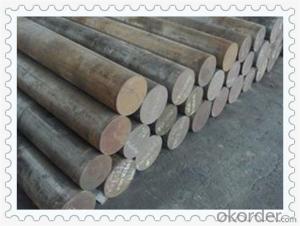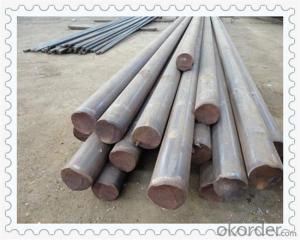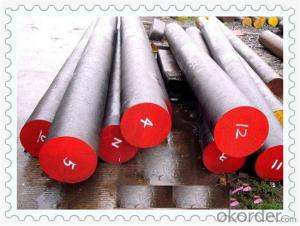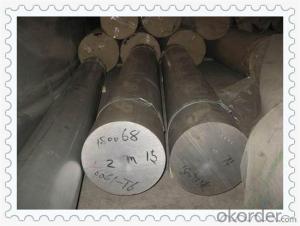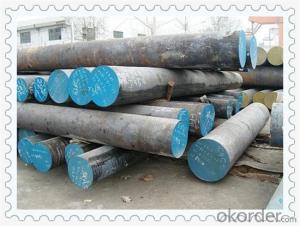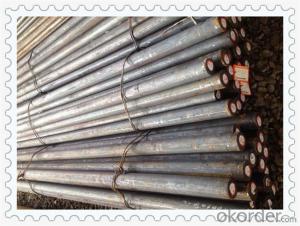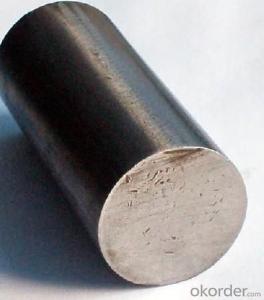Hot Rolled 1065 High Carbon Steel Bars
- Loading Port:
- China main port
- Payment Terms:
- TT OR LC
- Min Order Qty:
- 30 m.t.
- Supply Capability:
- 10000 m.t./month
OKorder Service Pledge
OKorder Financial Service
You Might Also Like
Hot Rolled 1065 High Carbon Steel Bars
Technical Paramenters
Description | 1065 steel rould bar | |
Material Range | ASTM /AISI | 1005,1006,1008,1010,1015,1020,1025,1030,1035, 1040,1045,1050,1055,1060,1065,1070,1080,1084 |
DIN | Ck10,Ck15,Ck22,Ck25,Ck30,Ck35,Ck40,Ck45,Ck50, 30Mn4,40Mn4 | |
Standard | GB/T799,ASTM A29,A36,A108,A321,A575,BS970,DIN1652,JIS G4051 | |
Section shape | Round Other shape such as square,hexagonal,flat,angle | |
Surface | Black, galvanized,grinded, | |
Specifications | Round bar | Diameter: 12mm~650mm |
Angle bar | Size: 3mm*20mm*20mm~12mm*800mm*800mm | |
Square/ bar | Size: 4mm*4mm~100mm*100mm | |
Flat bar | Thickness: 2mm~100mm | |
Width:10mm~500mm | ||
Hexagonal | Size: 4mm~800mm | |
Length | Standard 6m,9m,12m or as required. | |
Trade terms | Payment terms | T/T,L/C,Western Union |
Price terms | FOB,CIF,CFR,EXW | |
Applications | Steel round bar is widely used for all general fabrication and repairs in industrial maintenance, agricultural implements, transportation equipment, ornamental work frame work, braces, supports, shafts,axels,etc. Hot rolled Steel round bars have a slightly grain textured finish. | |
Products Show

Product Overviews
| Product Name | Typical Grades | Diameter(mm) | Standard adopted |
| Carbon Steel | 20 (1020/S20C/C22) | Ø16-Ø300 |
GB/SAE/JIS/DIN
|
| 40 (1040/S40C/C40) | |||
| 45 (1045/S45C/C45) | |||
| Bearing Steel | GCr9 (51100/SUJ1) | Ø12-Ø250 | |
| GCr15 (52100/SUJ2/100Gr6) | |||
| GCr9SiMn (A485-Gr.1/SUJ3) | |||
Cr-Mo Steel | 20Cr (5120/SCr420H/20Cr4) | Ø12-Ø250 | |
| 40Cr (5140/SCr440/41Cr4) | |||
| 42CrMo(4140/SCM440/42CrMo4) | |||
| Gear Steel | 20CrNiMo | Ø16-Ø600 | |
| 20CrMn(5115/SMnC420/20MnCr5) | |||
| 20CrNiMo(8620/SNCM220/20CrMiMo2) |
Application
| Carbon Steel | Mold bottom, Plastic mold, Construction machinery parts Automobile parts, Security grills, Screens, Construction |
| Bearing Steel | Aerospace, Navigation, Nuclear energy, Chemical industry Electronic information, Petrochemical, Instrument and meter Transportation |
| Cr-Mo Steel | Mechanism & Fasteners gear, Stressed components for vehicles Engines and machines, Parts of larger cross-section |
| Gear Steel | All kinds of gears, Statically and dynamically stressed component for vehicles Engines and machine, Larger cross-section parts, Crankshafts |
Work Shop

Company Information
CNBM International Corporation is the most important trading platform of CNBM group.
Whith its advantages, CNBM International are mainly concentrate on Cement, Glass, Iron and Steel, Ceramics industries and devotes herself for supplying high qulity series of refractories as well as technical consultancies and logistics solutions.


FAQ
1, Your advantages?
professional products inquiry, products knowledge train (for agents), smooth goods delivery, excellent customer solution proposale
2, Test & Certificate?
SGS test is available, customer inspection before shipping is welcome, third party inspection is no problem
3, Factory or Trading Company?
CNBM is a trading company but we have so many protocol factories and CNBM works as a trading department of these factories. Also CNBM is the holding company of many factories.
4, Payment Terms?
30% TT as deposit and 70% before delivery.
Irrevocable L/C at sight.
5, Trading Terms?
EXW, FOB, CIF, FFR, CNF
6, After-sale Service?
CNBM provides the services and support you need for every step of our cooperation. We're the business partner you can trust.
For any problem, please kindly contact us at any your convenient time.
We'll reply you in our first priority within 24 hours.
Packaging & Delivery
1, Packaging: seaworthy package or as required
2, Delivery: 35-45 days or based on quantity

- Q:What are the different surface defects that can occur in steel round bars?
- There are several different surface defects that can occur in steel round bars. These defects can be classified into various categories based on their appearance and severity. Some of the common surface defects include: 1. Scale: Scale is a thin layer of oxide that forms on the surface of steel during the manufacturing process. It appears as a rough, flaky coating and can be easily removed by mechanical means. 2. Pits: Pits are small depressions or craters that can occur on the surface of the steel. They are usually caused by corrosion or mechanical damage. Pits can weaken the structural integrity of the steel and may require repair or replacement. 3. Scratches: Scratches are shallow grooves or cuts on the surface of the steel. They can be caused by handling, transportation, or machining processes. While minor scratches may not affect the performance of the steel, deep scratches can lead to stress concentration and potential failure. 4. Roll marks: Roll marks are raised or depressed lines or patterns that are left on the surface of the steel during the rolling process. These marks are typically caused by the uneven pressure distribution between the rolls and can affect the dimensional accuracy and surface quality of the steel. 5. Laminations: Laminations are thin layers or bands of non-metallic inclusions that can occur parallel to the surface of the steel. They are usually caused by inadequate refining or improper casting techniques. Laminations can decrease the strength and toughness of the steel and may require further processing or rejection. 6. Decarburization: Decarburization refers to the loss of carbon content on the surface of the steel. It can occur during heating, annealing, or hot working processes. Decarburization can reduce the hardness and strength of the steel and may lead to premature failure under load. 7. Surface cracks: Surface cracks are visible cracks that occur on the surface of the steel. They can be caused by excessive cooling rates, improper heat treatment, or mechanical stress. Surface cracks can compromise the structural integrity of the steel and may require repairs or rejection. These are just a few examples of the different surface defects that can occur in steel round bars. It is essential to inspect and address these defects to ensure the quality and performance of the steel in various applications.
- Q:How do you prevent scaling of steel round bars during heat treatment?
- To minimize scaling of steel round bars during heat treatment, various steps can be taken: 1. Employ a protective atmosphere: Heat treatment can be conducted in a controlled gas environment, such as a furnace with regulated gas composition. This shields the steel bars from oxygen exposure, the main cause of scaling. 2. Employ a protective coating: Coating the steel round bars with a substance like refractory material or a thin layer of paint can help prevent scaling. This creates a barrier between the steel and the oxygen in the atmosphere, reducing the likelihood of scaling. 3. Use a reducing atmosphere: Instead of a regular atmospheric environment, heat treatment can be carried out in a reducing atmosphere. This involves introducing gases like hydrogen or nitrogen into the furnace, reacting with oxygen to create a controlled environment that prevents scaling. 4. Control the heating rate: Rapid heating can lead to increased scaling due to sudden exposure to high temperatures. By controlling the heating rate, such as gradually increasing temperature, scaling can be minimized. 5. Limit the exposure time: Reducing the duration that steel round bars are exposed to high temperatures helps prevent scaling. This can be achieved by optimizing the heat treatment process and avoiding prolonged exposure to elevated temperatures. 6. Clean the surface before heat treatment: Before heat treatment, it is essential to remove any contaminants or residues from the surface of the steel round bars. This can be achieved through mechanical methods like wire brushing or chemical cleaning techniques, ensuring a clean surface that is less prone to scaling. Implementing these preventive measures effectively minimizes scaling of steel round bars during heat treatment, resulting in improved quality and performance of the treated bars.
- Q:What are the advantages of using steel round bars compared to other materials?
- There are several advantages to using steel round bars compared to other materials. Firstly, steel is known for its strength and durability, making it ideal for heavy-duty applications. It can withstand high temperatures, pressure, and heavy loads without warping or breaking. Secondly, steel round bars are highly versatile and can be easily machined, welded, and formed into various shapes and sizes, making them suitable for a wide range of applications. Additionally, steel is a cost-effective option as it provides excellent long-term value due to its durability and low maintenance requirements. Lastly, steel is a sustainable and environmentally friendly material as it can be recycled and reused indefinitely without losing its properties.
- Q:What are the different grades of steel round bars?
- There are several different grades of steel round bars, each with its own unique properties and characteristics. Some of the most common grades include: 1. Mild Steel: Also known as low carbon steel, this grade is the most widely used due to its affordability and versatility. It has a relatively low carbon content and is easy to weld and form. 2. Carbon Steel: This grade contains a higher carbon content than mild steel, making it stronger and more durable. It is commonly used in applications that require high strength and hardness, such as construction and machinery. 3. Alloy Steel: Alloy steel round bars are made by combining different elements, such as chromium, nickel, or molybdenum, with carbon steel. This creates a material with enhanced properties, such as increased corrosion resistance, improved toughness, and higher tensile strength. 4. Stainless Steel: Stainless steel round bars are made primarily from iron and contain a minimum of 10.5% chromium. This grade of steel is known for its excellent corrosion resistance and is commonly used in applications where hygiene and cleanliness are crucial, such as in the food and pharmaceutical industries. 5. Tool Steel: Tool steel round bars are specifically designed to withstand high temperatures, heavy loads, and repeated impacts. They have excellent hardness, wear resistance, and toughness, making them suitable for manufacturing tools and dies. 6. High-Speed Steel (HSS): HSS round bars are a type of tool steel that can withstand high cutting speeds without losing their hardness. They are commonly used in applications that involve cutting, drilling, or machining at high speeds, such as in the manufacturing of drills and milling cutters. These are just a few of the many grades of steel round bars available, each designed to meet specific requirements in various industries and applications. It is important to select the appropriate grade based on factors such as strength, corrosion resistance, and desired properties for a particular project or usage.
- Q:What are the different types of steel alloy compositions used for round bars?
- Round bars are made from various steel alloy compositions, each with its own unique properties and applications. Some commonly used compositions include carbon steel, alloy steel, stainless steel, tool steel, duplex steel, and high-speed steel. Carbon steel is the basic and widely used type, consisting primarily of iron and carbon. It is known for its strength, durability, and affordability. Alloy steel, on the other hand, contains additional alloying elements like manganese, chromium, nickel, or molybdenum. This gives it enhanced strength, hardness, and resistance to wear, making it suitable for high-performance applications. Stainless steel, composed mainly of iron, chromium, and nickel, offers excellent corrosion resistance. It is ideal for environments with high moisture or chemical exposure, and it is often used in architectural and decorative applications. Tool steel is designed for exceptional hardness, toughness, and wear resistance. It is commonly used in the production of cutting tools, dies, and molds. Elements like tungsten, vanadium, or cobalt are added to enhance its performance. Duplex steel is a balanced combination of austenitic and ferritic microstructures. It provides excellent strength and corrosion resistance, making it suitable for demanding environments like the offshore oil and gas industry. High-speed steel is engineered to withstand high temperatures and maintain hardness and toughness at elevated speeds. It is frequently used in the production of cutting tools, drills, and milling cutters. Compositions containing elements like tungsten, molybdenum, or cobalt are typically used. These examples represent just a few of the steel alloy compositions available for round bars. The choice of composition depends on the specific application, desired properties, and performance requirements.
- Q:What are the tolerance standards for steel round bars?
- The tolerance standards for steel round bars differ based on specific requirements and industry norms. Generally, the tolerance for the diameter or size of steel round bars is specified as a plus or minus tolerance. This implies that the actual diameter of the bar may slightly deviate from the specified size, but it must fall within the specified tolerance range. In certain industries, like construction or manufacturing, the tolerance for steel round bars may be broader to facilitate easier fabrication and installation. For instance, a common tolerance range for the diameter of steel round bars used in construction could be ±0.005 to ±0.010 inches. In more precise applications, such as aerospace or automotive industries, the tolerance requirements for steel round bars are typically stricter. In these cases, the tolerance range can be significantly smaller, often ranging from ±0.001 to ±0.002 inches. It is important to note that different countries and organizations may have their own specific tolerance standards for steel round bars. These standards are usually outlined in industry-specific documents or specifications, such as ASTM (American Society for Testing and Materials) or ISO (International Organization for Standardization) standards. In summary, the tolerance standards for steel round bars vary depending on the specific requirements of the industry and application. The tolerance range for diameter can range from relatively broad to extremely tight, and these standards are typically defined by industry-specific organizations or standards bodies.
- Q:How are steel round bars used in the construction of stadiums and sports facilities?
- Steel round bars are commonly used in the construction of stadiums and sports facilities for their strength, durability, and versatility. These bars are often used as structural elements, providing support and stability to the overall structure. They can be used in the construction of columns, beams, and frames, ensuring the integrity and safety of the facility. Additionally, steel round bars are also used in the fabrication of seating structures, railings, and fencing, enhancing the aesthetic appeal and functionality of the sports venue.
- Q:What are the advantages of using nickel-tin alloy steel round bars?
- There are several advantages of using nickel-tin alloy steel round bars. Firstly, nickel-tin alloy steel has excellent corrosion resistance properties. This makes it ideal for applications where the round bars will be exposed to harsh environments or corrosive substances. The addition of nickel and tin enhances the overall durability and longevity of the round bars, ensuring they can withstand prolonged exposure to moisture, chemicals, and other corrosive elements. Secondly, nickel-tin alloy steel round bars offer superior strength and toughness. The combination of nickel and tin in the alloy composition enhances the overall mechanical properties of the bars, making them highly resistant to deformation, bending, and breaking. This makes them suitable for demanding applications that require high strength and durability, such as in construction, aerospace, and automotive industries. Additionally, nickel-tin alloy steel round bars exhibit excellent heat resistance. They can withstand high temperatures without significant loss of strength or deformation. This makes them ideal for applications that involve exposure to elevated temperatures, such as in furnaces, boilers, and heat exchangers. Furthermore, nickel-tin alloy steel is known for its excellent electrical conductivity. This property makes the round bars suitable for applications that require efficient electrical transmission, such as in electrical wiring, power generation, and electrical equipment manufacturing. Lastly, nickel-tin alloy steel round bars are relatively easy to machine and fabricate. They can be readily shaped, cut, and welded, allowing for versatility in various manufacturing processes. This ease of machining and fabrication ensures efficient production and reduces overall manufacturing costs. In conclusion, the advantages of using nickel-tin alloy steel round bars include excellent corrosion resistance, superior strength and toughness, high heat resistance, good electrical conductivity, and ease of machining and fabrication. These properties make nickel-tin alloy steel round bars a preferred choice for a wide range of applications in various industries.
- Q:How do I choose the right grade of steel round bar for my application?
- Choosing the right grade of steel round bar for your application requires careful consideration of several factors. Here are some steps to help you make an informed decision: 1. Determine the application requirements: Start by understanding the specific demands of your application. Consider factors such as load-bearing capacity, corrosion resistance, temperature resistance, and any specific industry standards or regulations that may apply. 2. Identify the required mechanical properties: Depending on the application, you may need specific mechanical properties such as strength, hardness, toughness, or ductility. Identify the required values for these properties and prioritize them based on their importance to your application. 3. Consider the environmental conditions: Evaluate the conditions in which the steel round bar will operate. This includes factors such as exposure to moisture, chemicals, high temperatures, or abrasive environments. Some grades of steel are more resistant to corrosion or heat, making them more suitable for specific conditions. 4. Consult with experts: If you are unsure about the best grade of steel for your application, seek advice from professionals such as metallurgists, engineers, or suppliers. They can provide valuable insights based on their expertise and experience. 5. Compare different grades: Once you have a clear understanding of your application requirements, research and compare different grades of steel round bars available on the market. Consider factors such as composition, manufacturing process, and specific properties of each grade. Look for grades that closely match your requirements. 6. Review industry standards and specifications: Check if there are any industry standards or specifications that dictate the use of specific grades for your application. These standards can provide guidance and ensure compliance with safety and quality requirements. 7. Evaluate cost-effectiveness: Evaluate the cost-effectiveness of different grades by considering factors such as initial purchase cost, maintenance and replacement costs, and the overall lifespan of the steel round bar. 8. Conduct tests and trials: If possible, conduct tests or trials using different grades of steel round bars to assess their performance in your specific application. This can provide valuable data and help you make a more informed decision. By following these steps and considering all relevant factors, you can choose the right grade of steel round bar that will meet the demands of your application efficiently and effectively.
- Q:Can steel round bars be used for making stabilizer bars?
- Yes, steel round bars can be used for making stabilizer bars. Steel round bars are commonly used in various industries, including automotive, for their high strength and durability. Stabilizer bars require materials that can withstand heavy loads and provide stability, making steel round bars an ideal choice for their construction.
1. Manufacturer Overview |
|
|---|---|
| Location | |
| Year Established | |
| Annual Output Value | |
| Main Markets | |
| Company Certifications | |
2. Manufacturer Certificates |
|
|---|---|
| a) Certification Name | |
| Range | |
| Reference | |
| Validity Period | |
3. Manufacturer Capability |
|
|---|---|
| a)Trade Capacity | |
| Nearest Port | |
| Export Percentage | |
| No.of Employees in Trade Department | |
| Language Spoken: | |
| b)Factory Information | |
| Factory Size: | |
| No. of Production Lines | |
| Contract Manufacturing | |
| Product Price Range | |
Send your message to us
Hot Rolled 1065 High Carbon Steel Bars
- Loading Port:
- China main port
- Payment Terms:
- TT OR LC
- Min Order Qty:
- 30 m.t.
- Supply Capability:
- 10000 m.t./month
OKorder Service Pledge
OKorder Financial Service
Similar products
New products
Hot products
Related keywords
